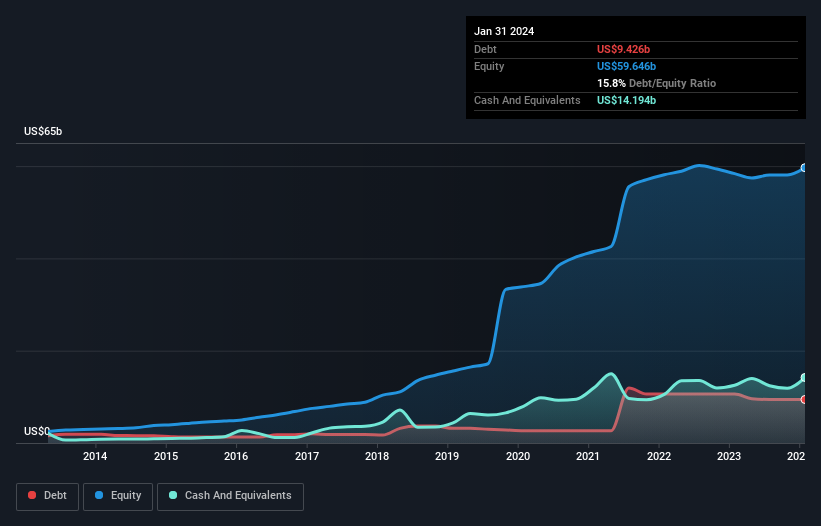Salesforce (NYSE:CRM) Could Easily Take On More Debt
Warren Buffett famously said, 'Volatility is far from synonymous with risk.' So it seems the smart money knows that debt - which is usually involved in bankruptcies - is a very important factor, when you assess how risky a company is. As with many other companies Salesforce, Inc. (NYSE:CRM) makes use of debt. But should shareholders be worried about its use of debt?
Why Does Debt Bring Risk?
Debt and other liabilities become risky for a business when it cannot easily fulfill those obligations, either with free cash flow or by raising capital at an attractive price. If things get really bad, the lenders can take control of the business. However, a more frequent (but still costly) occurrence is where a company must issue shares at bargain-basement prices, permanently diluting shareholders, just to shore up its balance sheet. Of course, plenty of companies use debt to fund growth, without any negative consequences. When we think about a company's use of debt, we first look at cash and debt together.
Check out our latest analysis for Salesforce
How Much Debt Does Salesforce Carry?
You can click the graphic below for the historical numbers, but it shows that Salesforce had US$9.43b of debt in January 2024, down from US$10.6b, one year before. But it also has US$14.2b in cash to offset that, meaning it has US$4.77b net cash.
How Strong Is Salesforce's Balance Sheet?
We can see from the most recent balance sheet that Salesforce had liabilities of US$26.6b falling due within a year, and liabilities of US$13.5b due beyond that. Offsetting this, it had US$14.2b in cash and US$11.4b in receivables that were due within 12 months. So its liabilities outweigh the sum of its cash and (near-term) receivables by US$14.6b.
Of course, Salesforce has a titanic market capitalization of US$285.5b, so these liabilities are probably manageable. However, we do think it is worth keeping an eye on its balance sheet strength, as it may change over time. Despite its noteworthy liabilities, Salesforce boasts net cash, so it's fair to say it does not have a heavy debt load!
Even more impressive was the fact that Salesforce grew its EBIT by 223% over twelve months. If maintained that growth will make the debt even more manageable in the years ahead. There's no doubt that we learn most about debt from the balance sheet. But it is future earnings, more than anything, that will determine Salesforce's ability to maintain a healthy balance sheet going forward. So if you want to see what the professionals think, you might find this free report on analyst profit forecasts to be interesting.
Finally, a company can only pay off debt with cold hard cash, not accounting profits. While Salesforce has net cash on its balance sheet, it's still worth taking a look at its ability to convert earnings before interest and tax (EBIT) to free cash flow, to help us understand how quickly it is building (or eroding) that cash balance. Over the last three years, Salesforce actually produced more free cash flow than EBIT. That sort of strong cash generation warms our hearts like a puppy in a bumblebee suit.
Summing Up
We could understand if investors are concerned about Salesforce's liabilities, but we can be reassured by the fact it has has net cash of US$4.77b. The cherry on top was that in converted 251% of that EBIT to free cash flow, bringing in US$9.5b. So we don't think Salesforce's use of debt is risky. When analysing debt levels, the balance sheet is the obvious place to start. But ultimately, every company can contain risks that exist outside of the balance sheet. To that end, you should be aware of the 2 warning signs we've spotted with Salesforce .
When all is said and done, sometimes its easier to focus on companies that don't even need debt. Readers can access a list of growth stocks with zero net debt 100% free, right now.
Have feedback on this article? Concerned about the content? Get in touch with us directly. Alternatively, email editorial-team (at) simplywallst.com.
This article by Simply Wall St is general in nature. We provide commentary based on historical data and analyst forecasts only using an unbiased methodology and our articles are not intended to be financial advice. It does not constitute a recommendation to buy or sell any stock, and does not take account of your objectives, or your financial situation. We aim to bring you long-term focused analysis driven by fundamental data. Note that our analysis may not factor in the latest price-sensitive company announcements or qualitative material. Simply Wall St has no position in any stocks mentioned.

